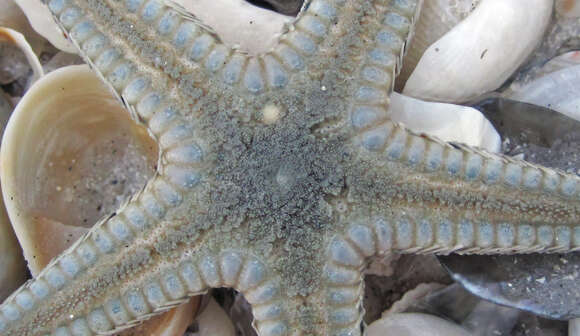Astropecten sp. starfish (Cayo Costa Island, Florida, USA) 2 (24199888942)

Description:
Description: Astropecten sp. starfish in Florida, USA (January 2016). Starfish are vagrant, benthic, mostly predatory echinoderms. They have a multielement skeleton composed of numerous, small, calcitic plates. Most starfish are pentaradial (they have 5 arms), but some species have 6 or more arms. Many starfish are predators, although some can deposit feed. Predatory starfish include forms that consume prey, usually bivalves, by everting their stomachs through their mouths (= centrally located on the underside) and digest food externally. About 150 species of Astropecten are known from modern oceans. The oldest fossils of Astropecten sensu stricto are Eocene. Unlike many starfish, Astropecten does not engage in stomach eversion behavior. Instead, Astropecten consumes its prey whole and has internal digestion. The off-center, whitish-colored structure in the central disc area of the starfish shown above is the madreporite, which draws in or expels water from the organism's water vascular system. Classification: Animalia, Echinodermata, Asteroidea, Paxillosida, Astropectinidae Locality: marine beach at the southern tip of Cayo Costa Island, Gulf of Mexico coast of southwestern Florida, USA (vicinity of 26° 36' 48.74" North latitude, 82° 13' 19.91" West longitude) Astropecten-specific info. from: Lawrence (2013) - Starfish, Biology and Ecology of the Asteroidea. Baltimore. Johns Hopkins University Press. 288 pp. More info. at: en.wikipedia.org/wiki/Starfish and en.wikipedia.org/wiki/Astropecten. Date: 5 January 2016, 16:14. Source: Astropecten sp. starfish (Cayo Costa Island, Florida, USA) 2. Author: James St. John.
Included On The Following Pages:
- Life (creatures)
- Cellular (cellular organisms)
- Eukaryota (eukaryotes)
- Opisthokonta (opisthokonts)
- Metazoa (Animal)
- Bilateria
- Deuterostomia (deuterostomes)
- Echinodermata (echinoderms)
- Asterozoa ("Starfish, brittle stars, and basket stars")
- Asteroidea (sea stars)
- Valvatacea
- Paxillosida
- Astropectinidae
- Astropecten (Comb sea star)
This image is not featured in any collections.
Source Information
- license
- cc-by-3.0
- copyright
- James St. John
- creator
- James St. John
- source
- Flickr user ID jsjgeology
- original
- original media file
- visit source
- partner site
- Wikimedia Commons
- ID


